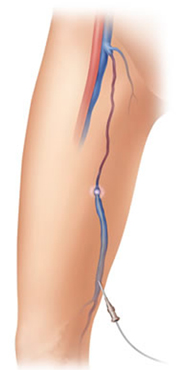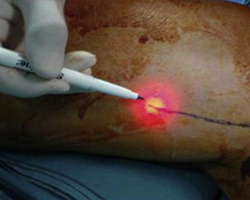Which patients may undergo EVLT?
Any person with Varicose veins, whether OR not they are Symptomatic, can consider Laser ablation. Feasibility of the procedure depends on whether the Long /short Saphenous vein has a fairly straight course, where by allowing the laser fiber to pass upto the incompetent junction.
 How is it done?
How is it done?
A fine ELVeS laser fibre is introduced into the diseased vein through a fine needle. Local anaesthesia is then given once the fibre has been placed 2 cms from the saphenofemoral junction. Under ultrasonographic guidance, very dilute, high volume local tumescent anesthetic is injected around the vessel to be ablated until a halo of tumescence is observed along the entire length of the vessel, separating it from its fascial sheath.
 Once in position the laser energy is delivered in short pulses causing thermal damage of the vein wall and a complete occlusion of the vein.
Once in position the laser energy is delivered in short pulses causing thermal damage of the vein wall and a complete occlusion of the vein.
Firm pressure is applied to collapse the vein around the laser fiber, and the laser is fired with settings sufficient to cause irreversible thermal endothelial damage.
The whole procedure takes about 60 minutes and the patient can return to normal activities immediately.
 Smaller veins like Spider Veins can be treated through the skin with the same laser system using a hand piece. Small vessels upto 1.5 mm can be easily treated in the same manner without any need for anaesthesia.
Smaller veins like Spider Veins can be treated through the skin with the same laser system using a hand piece. Small vessels upto 1.5 mm can be easily treated in the same manner without any need for anaesthesia.
The patient may have some pain and inflamation for 3 – 4 days after the procedure which settles down on it’s own with minimal medication. The patient is recommended to wear compression stockings for 2 months after the procedure.
“ Needless to say, the procedure is free of any pain”
Post – Procedure Care
- Compression Bandage for 24 hrs. These elastic bandages should not be used beyond 24 hrs. They fail to maintain adequate compression for more than a few hours. They often slip or are misapplied by patients, with a resulting tourniquet effect that causes distal swelling and increases the risk of DVT.
- Graduated Compression Stocking for next 2 weeks.
- Activity is particularly important after treatment by any technique because all modalities of treatment for varicose disease have the potential to increase the risk of DVT. Activity is a strong protective factor against venous stasis. Activity is so important that most venous specialists will not treat a patient who is unable to remain active following treatment
Advantages
- Short Treatment time – Day care procedure.
- Excellent Cosmetic Results – No surgical scars.
- Can be done under local anaesthesia.
- Early Return to work
- Highly Cost Effective
Disadvantages
- Only laser treatment is never effective in treating varicose veins.
- Mostly combination procedures are required.
- May need general or regional anaesthesia as, Local anaesthesia procedure can be painful.
- Difficult in obese patients.
- The results for branch varicosities is pathetic and needs either surgical removal or injection Sclerotherapy.

